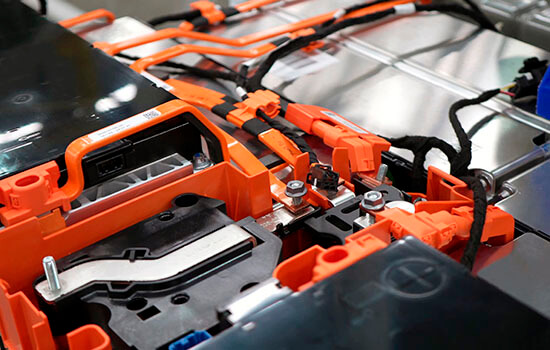District 3 County Commissioner Brandon Arrington Hosts Government Resource Fair Focused on Transportation and Community Services – Positively Osceola

Government Resource Fair Aligns with Sustainable Development Goals in Osceola County
Executive Summary
In response to rapid regional growth, the Osceola County Commission hosted its inaugural Government Resource Fair. The event, held at Valencia College’s Poinciana Campus, was designed to connect residents with essential services and community partners. This initiative directly supports several United Nations Sustainable Development Goals (SDGs), particularly those focused on sustainable cities, resilient infrastructure, strong institutions, and multi-stakeholder partnerships.
A Multi-Stakeholder Approach to Sustainable Development (SDG 17)
The resource fair exemplified SDG 17: Partnerships for the Goals by creating a collaborative platform for various entities. This partnership model is crucial for addressing complex development challenges.
- Government Agencies: County departments, transportation authorities, and public safety officials provided direct engagement.
- Elected Officials: Representatives from local, state, and federal offices were present to ensure accountability and accessibility.
- Community Organizations: Non-profits focusing on health, education, and research offered specialized resources.
Developing Sustainable Cities and Communities (SDG 11)
The fair’s primary focus was on challenges and solutions integral to SDG 11: Sustainable Cities and Communities, which aims to make human settlements inclusive, safe, resilient, and sustainable.
Resilient Infrastructure and Sustainable Transport (SDG 9 & SDG 11.2)
A significant portion of the event was dedicated to infrastructure, a cornerstone of SDG 9: Industry, Innovation, and Infrastructure. Updates were provided on key projects designed to create sustainable transport systems for all, in line with SDG 11.2.
- Southport Connector Expressway PD&E Study: A proposed 15-mile expressway to improve connectivity, which includes plans for a multi-use trail to support sustainable transport options.
- Northeast Connector Expressway Study: A project outlining future road segments to enhance the regional transportation network.
- Public Transit Updates: Information was shared by LYNX and SunRail, promoting access to affordable and sustainable public transportation.
Affordable Housing and Community Services (SDG 11.1)
The presence of the Housing & Community Services department and housing advocates directly addressed targets within SDG 11.1, which focuses on ensuring access to adequate, safe, and affordable housing.
Public Safety and Green Spaces (SDG 11.7 & SDG 15)
The fair promoted community well-being through:
- Public Safety: Engagement with the Osceola County Sheriff’s Office and Fire Rescue & EMS reinforced community safety.
- Access to Green Spaces: The Parks & Public Lands Department contributed by distributing free trees, an initiative that supports SDG 11.7 (access to green public spaces) and SDG 15: Life on Land by promoting local ecosystems.
Enhancing Health, Well-being, and Climate Resilience
Good Health and Well-being (SDG 3)
The participation of Osceola Community Health Services and other health professionals supported SDG 3: Good Health and Well-being by providing residents with access to vital health information and resources.
Climate Action and Adaptation (SDG 13)
In a direct contribution to SDG 13: Climate Action, the Osceola County Emergency Management department equipped residents with tools for climate resilience, including:
- Weather radios for early warnings.
- QuickDam sandbags for flood mitigation.
Building Strong and Transparent Institutions (SDG 16)
The event was a practical application of SDG 16: Peace, Justice, and Strong Institutions, which calls for effective, accountable, and inclusive institutions at all levels. By bringing government services directly to the community, the fair fostered transparency and accessibility. Vice Chairman Brandon Arrington stated the event’s purpose was to “bring government closer to the people” and ensure residents are informed about critical issues affecting their lives.
Conclusion
The Osceola County Government Resource Fair served as a successful model for localized implementation of the Sustainable Development Goals. By integrating efforts across transportation, housing, health, public safety, and environmental stewardship, the initiative demonstrated a holistic commitment to building a sustainable and resilient community for its growing population.
Analysis of Sustainable Development Goals in the Article
1. Which SDGs are addressed or connected to the issues highlighted in the article?
- SDG 3: Good Health and Well-being: The article mentions the presence of “health professionals” and “Osceola Community Health Services” at the fair, directly linking to community health. Additionally, the focus on public safety, with the participation of “Emergency Management,” “Osceola County Sheriff’s Office,” and “Fire Rescue & EMS,” contributes to the well-being and safety of residents.
- SDG 9: Industry, Innovation and Infrastructure: This goal is central to the article, which highlights transportation infrastructure as a “primary focus.” The detailed discussion of major projects like the “Southport Connector Expressway” and the “Northeast Connector Expressway” directly relates to developing reliable and resilient infrastructure to support the county’s rapid growth.
- SDG 11: Sustainable Cities and Communities: The article is fundamentally about managing urban growth. It addresses key components of sustainable communities, including “transportation infrastructure,” “public safety,” “housing,” and the provision of green spaces through the distribution of free trees by the “Parks & Public Lands Department.”
- SDG 16: Peace, Justice and Strong Institutions: The entire Government Resource Fair is an initiative to build stronger, more accessible institutions. The article notes the event’s aim was to foster “transparency and accessibility” and quotes Vice Chair Arrington saying it was about “bringing government closer to the people,” which aligns with developing effective and accountable institutions.
2. What specific targets under those SDGs can be identified based on the article’s content?
-
SDG 3: Good Health and Well-being
- Target 3.d: Strengthen the capacity of all countries, in particular developing countries, for early warning, risk reduction and management of national and global health risks. This is addressed through the “Osceola County Emergency Management Director” providing residents with “weather radios, and QuickDam sandbags,” which are tools for risk reduction and preparedness for natural disasters that pose health risks.
-
SDG 9: Industry, Innovation and Infrastructure
- Target 9.1: Develop quality, reliable, sustainable and resilient infrastructure… to support economic development and human well-being. The article details plans for significant infrastructure development to manage growth, including the “Southport Connector Expressway PD&E Study,” which proposes a “15-mile expressway,” and the “Northeast Connector Expressway Study.” These projects are designed to improve connectivity and support the well-being of residents in a “rapidly developing district.”
-
SDG 11: Sustainable Cities and Communities
- Target 11.1: By 2030, ensure access for all to adequate, safe and affordable housing and basic services. The article identifies “housing” as a “pressing issue” and a “key concern.” The presence of “Housing & Community Services” at the fair indicates an effort to connect residents with services and information related to housing access.
- Target 11.2: By 2030, provide access to safe, affordable, accessible and sustainable transport systems for all. This is addressed by the comprehensive transportation updates from agencies like “LYNX” and “SunRail” and projects that include “widening Cypress Parkway to six lanes, enhancing eight intersections, and constructing a multi-use trail,” which improves road systems and provides sustainable transport options.
- Target 11.3: By 2030, enhance inclusive and sustainable urbanization and capacity for participatory, integrated and sustainable human settlement planning and management. The resource fair itself is a direct example of this target. It is a “participatory” event that brings together “residents, government services, and community partners” for “one-on-one engagement” to manage the challenges of rapid growth in an integrated manner.
- Target 11.7: By 2030, provide universal access to safe, inclusive and accessible, green and public spaces. This is directly supported by the “Parks & Public Lands Department” which “distributed free trees, promoting sustainability and neighborhood beautification,” an action that contributes to creating green spaces within the community.
-
SDG 16: Peace, Justice and Strong Institutions
- Target 16.6: Develop effective, accountable and transparent institutions at all levels. The article states that a goal of the fair was “fostering transparency and accessibility,” which directly aligns with this target. By bringing numerous government departments and elected officials to interact directly with the public, the county is working to create more transparent and accountable governance.
- Target 16.7: Ensure responsive, inclusive, participatory and representative decision-making at all levels. The event is described as an opportunity for residents to “meet directly with leaders,” “ask questions,” and have “one-on-one engagement.” This format exemplifies a “participatory” approach to governance, ensuring that institutions are responsive to citizen concerns about “issues that affect our daily lives, like traffic, housing, and public safety.”
3. Are there any indicators mentioned or implied in the article that can be used to measure progress towards the identified targets?
-
SDG 3: Good Health and Well-being
- Indicator (Implied): Number of emergency preparedness items distributed. The article explicitly mentions the distribution of “weather radios, and QuickDam sandbags,” which can be counted to measure progress on disaster risk reduction (Target 3.d).
-
SDG 9: Industry, Innovation and Infrastructure
- Indicator (Mentioned): Length of new roads planned. The article specifies a “15-mile expressway” as part of the “Southport Connector Expressway PD&E Study,” providing a quantifiable measure of infrastructure development (Target 9.1).
-
SDG 11: Sustainable Cities and Communities
- Indicator (Mentioned): Length of multi-use trails constructed. The plan to construct a “multi-use trail” is a specific, measurable action toward providing sustainable transport systems (Target 11.2).
- Indicator (Mentioned): Number of intersections enhanced. The plan for “enhancing eight intersections” is a direct indicator of improving road safety and transport systems (Target 11.2).
- Indicator (Implied): Number of participatory planning events held. The “county’s first-ever Government Resource Fair” is itself an indicator of progress toward participatory urban planning and management (Target 11.3).
- Indicator (Mentioned): Number of trees distributed. The article states the “Parks & Public Lands Department distributed free trees,” which is a direct and measurable indicator of efforts to increase green spaces (Target 11.7).
-
SDG 16: Peace, Justice and Strong Institutions
- Indicator (Implied): Number of residents engaged in participatory events. The “overwhelmingly positive response from attendees” implies a significant level of public participation, which can be measured to track progress on inclusive decision-making (Target 16.7).
- Indicator (Implied): Number of government departments participating in public outreach. The article lists numerous departments (“Emergency Management, Housing & Community Services, Veterans Services,” etc.), and counting them serves as an indicator of institutional commitment to transparency (Target 16.6).
4. Summary Table of SDGs, Targets, and Indicators
| SDGs | Targets | Indicators |
|---|---|---|
| SDG 3: Good Health and Well-being | 3.d: Strengthen capacity for early warning, risk reduction and management of health risks. | Number of emergency preparedness items distributed (e.g., “weather radios, and QuickDam sandbags”). |
| SDG 9: Industry, Innovation and Infrastructure | 9.1: Develop quality, reliable, sustainable and resilient infrastructure. | Length of new roads planned (e.g., “15-mile expressway”). |
| SDG 11: Sustainable Cities and Communities | 11.1: Ensure access for all to adequate, safe and affordable housing and basic services. | Presence of “Housing & Community Services” to address housing as a “pressing issue.” (Qualitative indicator) |
| 11.2: Provide access to safe, affordable, accessible and sustainable transport systems for all. | Number of intersections enhanced (“enhancing eight intersections”); Length of multi-use trails constructed (“constructing a multi-use trail”). | |
| 11.3: Enhance inclusive and sustainable urbanization and participatory planning. | Number of participatory planning events held (e.g., the “Government Resource Fair” itself). | |
| 11.7: Provide universal access to safe, inclusive and accessible, green and public spaces. | Number of trees distributed (“distributed free trees”). | |
| SDG 16: Peace, Justice and Strong Institutions | 16.6: Develop effective, accountable and transparent institutions at all levels. | Number of government departments participating in public outreach events to foster “transparency and accessibility.” |
| 16.7: Ensure responsive, inclusive, participatory and representative decision-making. | Number of residents engaged in participatory events providing “one-on-one engagement” with officials. |
Source: positivelyosceola.com

What is Your Reaction?
 Like
0
Like
0
 Dislike
0
Dislike
0
 Love
0
Love
0
 Funny
0
Funny
0
 Angry
0
Angry
0
 Sad
0
Sad
0
 Wow
0
Wow
0


-1920w.png?#)





































































